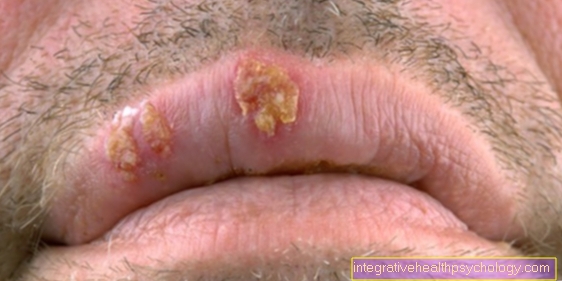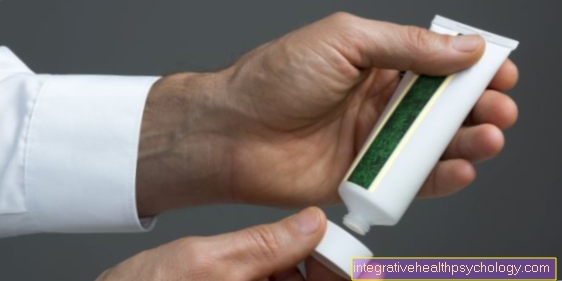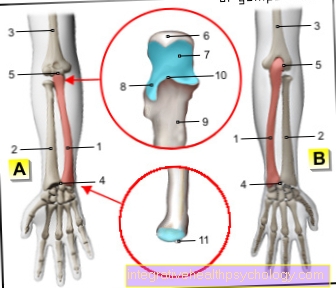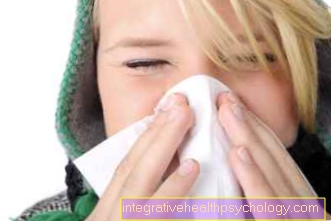Allergy to apples
introduction
The allergy to apples is one of the immediate type allergies.
This means that after eating the apple, a reaction is triggered by the immune system within seconds to minutes. The immediate type includes all food allergies, as well as pollen allergies.

causes
The apple allergy is one of the type 1 allergies of the immediate type. When an apple is consumed, the smallest structures, so-called antigens of the apple, are absorbed through the mucous membrane in the mouth. The immune system mistakenly recognizes these antigens as hazardous substances and triggers a complex inflammatory reaction.
Among other things, histamine is released, which then locally triggers the symptoms described below. In addition, memory cells are formed that can trigger a rapid immune response when they come into contact with apples again. The number of people who are allergic to apples is increasing. It is debated whether the chemical products commonly used in cultivation are related.
Read more on the topic: Food allergy
What are the symptoms of an apple allergy?
The symptoms of an apple allergy show up during consumption or shortly afterwards. They can be of different severity, so that there are only small local reactions on the mucous membrane in one person and pronounced and threatening symptoms in another.
- small blisters or pustules in the mouth and throat
- Burning or itching in the area that may spread to the tongue
- Mucous membrane swells quickly
- difficulties swallowing
- Shortness of breath
If these severe symptoms occur, a doctor should be consulted in any case, so that further complications can be prevented accordingly.
Read more on the topic: Symptoms of an allergy
Is there an allergy test?
An apple allergy can be examined with the prick test.
It is one of the standard diagnostics when it comes to clarifying allergies. It is important to carry out the test in the symptom-free interval and no more antihistamines may be taken. In this procedure, the allergen is dripped onto the skin in liquid form. A small needle is then used to prick the liquid in the skin. After a certain time, the reaction on the skin is assessed. In the case of an apple allergy, one would expect a clear skin reaction with reddening and swelling at the location of the apple allergen.
In addition to the prick test, you can also do an IgE test. The IgE is determined in the blood and an increased value would indicate positive allergy evidence. However, this method is unspecific. Finally, you can also do a provocation test with the doctor. Under medical supervision, you take some apple and the reaction is then closely monitored.
Read more on the topic: Allergy diagnostics
Which cross allergies can exist?
If you have an apple allergy, there are often other allergies to allergens that are similar to apples. People with an allergy to early bloomers, such as the birch, also tend to develop an allergy to apples. Cross allergies to cherry, peach or kiwi are also known.
Find out more about the topic: Cross allergy
Course of disease
The first time you come into contact with apples, the typical allergic symptoms do not usually occur.
Nevertheless, the immune system is already reacting in the background. After the smallest structures of the apple have penetrated through the mucous membrane into the bloodstream and the immune system has mistakenly recognized them as harmful, T-lymphocytes are reactively formed, which belong to the white blood cells of the immune system.
These T-lymphocytes then recognize the next contact with apple, the immune system is activated immediately and at lightning speed and symptoms develop. In the further course of the allergy, allergic reactions will occur again and again and no weakening can be expected. This is why it is so important to avoid these triggers if possible.
Is there a type of apple that you can still eat?
In principle, people with an apple allergy can develop an allergy to all apple varieties. However, one could observe that old apple varieties are better tolerated by allergy sufferers.
These apple varieties include Boskop, Gravensteiner, Goldparamäne or Berlepsch. Even of these more tolerable varieties, only a small piece should be eaten at first to test whether a reaction occurs or not. It is also important to wash the apples thoroughly before consuming them so that they do not react to any pesticides that may be present. Peeling also removes many of the antigens, making the apples even more digestible.
Am I allergic to apple juice too?
As a rule, processed apple products are well tolerated by allergy sufferers. This includes not only apple juice, but also applesauce or apple pie.
By removing the shell and especially by heating it, the antigens that are responsible for triggering the allergic reaction are rendered ineffective.
Nevertheless, as a precaution, a small amount of juice should be used to test whether a reaction is triggered.
therapy
Acute therapy depends on the severity of the allergic reaction. In general, it is important to remove the trigger of the allergy immediately. The severity of the allergic reaction can be assessed through a short conversation and an exploratory examination. A venous access is always necessary, as the drugs work faster through the vein. If the reaction is mild, it is usually sufficient to give an antihistamine such as dimetinden or clemastine in combination with a glucocorticoid via the vein.
If there are also problems breathing through the swollen mucous membrane, the stress hormone adrenaline would be injected into the muscle and the patient would be given oxygen to breathe. To open the airways, a spray can also be administered, which is also used in bronchial asthma.
In the case of extreme reactions associated with anaphylactic shock, all of the above measures would be taken and fluids would also be given through the vein. Constant monitoring of the vital parameters is important here, as anaphylactic shock can also turn into cardiovascular failure.
Therapy is always focused on improving symptoms and stabilizing the circulation. The allergy itself cannot yet be completely cured, which is why avoiding raw apples is the most effective preventive measure in this case to avoid further allergic reactions.
Further information on the subject can be found at:
- Food allergy therapy
- Active ingredients antihistamines
forecast
The allergic reaction to apple is an acute reaction of the immune system and therefore the process is usually not very lengthy. The duration depends on the severity of the reaction and how well the patient responds to the medication. The reactions on the mucous membrane should subside within a few days with appropriate treatment. In severe cases with obstruction of the airways, the administration of adrenaline and a spray, which dilates the airways, quickly improves the symptoms.
An allergy cannot yet be cured. Although there are procedures such as desensitization, these cannot be used for every allergy. However, in about 66% of patients they help to cease the allergy for a long time.

.jpg)





















.jpg)





